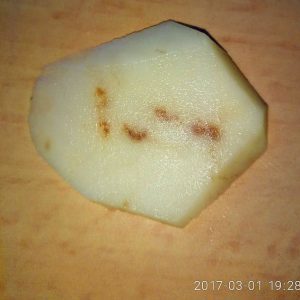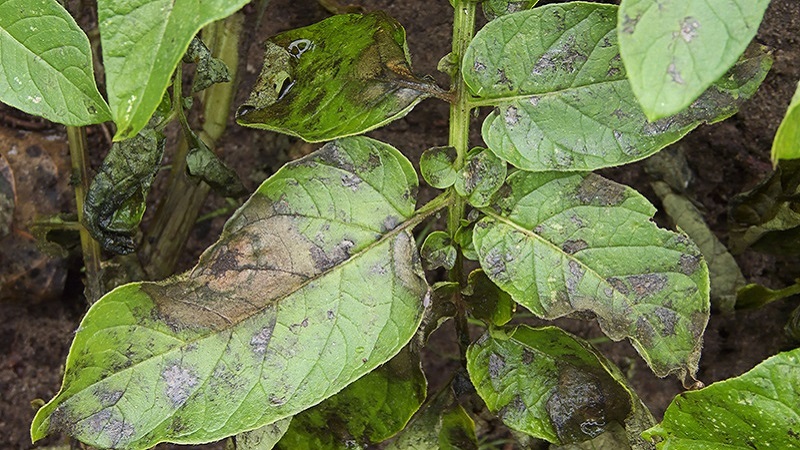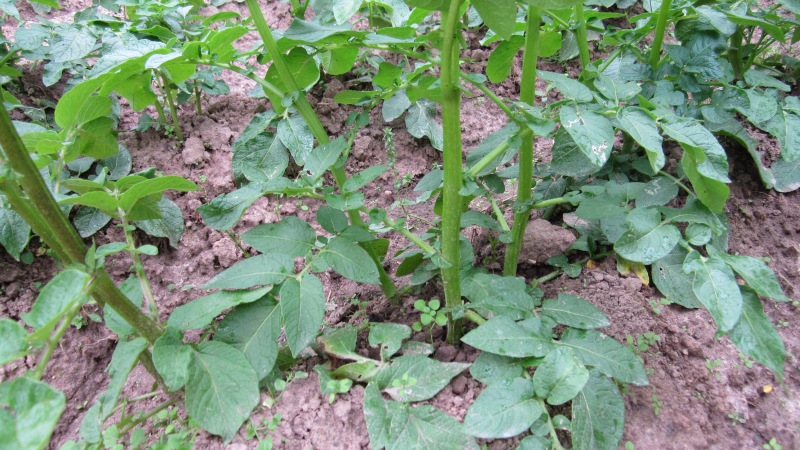Why are there spots on potatoes: measures to combat glandular spot and other diseases
Gardeners often notice spots of different shapes, colors and sizes on potatoes, which spoil not only the appearance of plants, but also yield... Such marks are signs of black leg, scab, glandular spot, Alternaria, or a feature of the variety. To get rid of the cause of the lesion, it is important to know what kind of disease causes the spots on the tubers and how to prevent it.
The content of the article
Description of diseases
Stained potatoes do not always mean that they are spoiled. Tubers lose their flavor and become unfit for eating only when severely damaged.

Rusty stains
Rust indicates the presence of glandular spot of potatoes. The disease occurs due to non-observance of agricultural practices, drought, high air temperature.
By the way! Some agronomists are inclined to the viral etiology of potato spot, but healthy bushes often grow from diseased tubers, which contradicts this version.
Brown
Blackleg is a bacterial disease from which it is difficult to save crops. In frosts, microorganisms feed on the roots remaining in the soil and survive until the next season. To avoid this, the beds are carefully weeded. Before the next planting, carefully examine the tubers.
Signs of infection:
- the presence of brown spots;
- the skin is dark gray;
- slurry with an unpleasant odor that pours out when pressed.
If contaminated vegetables end up in storage, the entire harvested crop will suffer.
Black
With melanosis of potatoes, dark, shapeless spots become noticeable, which turn black during cooking. To avoid this, the conditions for harvesting, transporting and storing the crop are observed.
If small black spots appear on the potatoes, a common cause of this is the fungal disease Alternaria. It occurs due to violation of the rules of crop rotation, planting crops next to other nightshades. Mushrooms reproduce by spores, gradually affecting all bushes. Potash and phosphorus fertilization will significantly strengthen the planting.
Red
Housewives sometimes notice red spots on them when peeling tubers, thinking that this is a sign of illness. In fact, such inclusions are safe and do not belong to the symptoms of damage. They arise due to the oversaturation of the soil with aluminum and iron, deficiency of potassium and phosphorus.
There are varieties for which redness is a natural feature.
Reference! The pulp of Krasnopolskaya potatoes has red spots and streaks... This is due to flavonoids - plant pigments responsible for color. During heat treatment, the spots fade and become almost indistinguishable. Tubers with such traits are suitable for human consumption.
Purple
Purple spots on potatoes are a feature of some varieties (Vitelot, Explosion, Lilac) or their hybrids. It happens that one part of the rind is brown and the other is purple. Spots of gray or black color are signs of a black leg or alternaria.
Varieties with purple pigmentation are whimsical in care and defenseless against scab and Colorado potato beetle... When propagated by eyes, the tubers become smaller, the culture becomes wild-growing. It is difficult to grow it, but the lilac puree or fries will attract the attention of guests.
White
Light spots indicate a silvery scab. The fungus parasitizes the peel. The disease occurs due to non-compliance with agricultural cultivation techniques.In hot weather, when the tubers are tied, the silvery spotting reaches its climax.
Attention! The disease often develops in loamy or sandy loam soil. During harvesting, the tubers are carefully examined, the affected specimens are burned.
Signs
Any disease has distinctive symptoms:
- Glandular spot - on the cut of the tuber, the peripheral lesion is visible. Rusty spots come in different sizes: from 1 mm to 2 cm. Appearing on the peel, the disease gradually penetrates into the pulp. Small spots merge into one large one. Potatoes are not rottingbut remains tough during heat treatment. The tubers left for planting do not deteriorate and are stored until the next season. They grow into healthy plants with proper care.

- Blackleg - leaves, stems and tubers are covered with brown spots. The potatoes crack, darken, and, when pressed, exude a fetid brown liquid that contains large amounts of bacteria. Infected bushes are burned.
- Melanosis - tubers are covered with dark spots that turn black during cooking.
- Alternaria - Leaves cover brown spots. Spores are carried by the wind and settle in the upper areas of the bush. In a few weeks, the fungus reaches the tubers, infects them, leaving black marks.
- Silvery scab - the disease becomes noticeable when the mycelium is sufficiently developed. Dark brown spots appear on the skin. With severe damage, dents are formed, covered with a silvery-white coating.
Timely detected symptoms will help to take timely measures and preserve the harvest.
The reasons
The problem has different origins, but a common cause of its occurrence is inaccuracies in care:
- Glandular spot - the appearance of the disease is affected by a deficiency of phosphorus and soil potassium, an excess of aluminum or abnormal summer heat.
- Blackleg - the infection is carried by insects, especially the Colorado potato beetle. If the infected seed is planted in the beds, the disease will actively progress. Favorable conditions for the development of bacteria are high humidity and heavy soil.
- Melanosis - occurs due to mechanical damage to tubers during transportation, too early harvesting time, storage of vegetables in warmth for more than 8 weeks, lack of potassium in the soil or oversaturation with nitrogenous fertilizers.
- Alternaria - progresses in hot dry weather. Young shoots are the first to suffer. At an advanced stage, spores penetrate into the tubers, but more often infection occurs during harvesting through the soil. Mushrooms love to parasitize on medium and late varieties of potatoes. One of the reasons for plant damage is the low level of minerals in the soil.
- Silvery scab - fungi develop in high soil moisture and warmth, when the greenhouse effect is created.

Control measures
There are different ways to counteract diseases: folk, chemical and biological.
Folk
These are the simplest methods of struggle available to every gardener:
- To protect the seed tubers from diseases, use a pale pink solution of potassium permanganate. The vegetables are immersed in a hot bath (+ 60 ° C) for 20-30 minutes. When symptoms of damage appear, the bushes are treated with the same solution.
- To protect the culture from silvery scab, the planting material is treated with a 1.5% boric acid solution. Bird droppings dissolved in water are added to the wells (1:15).
- From the glandular spot, the soil is saturated with lime, nitrogen or phosphorus, depending on which element is missing.
- At the first symptoms of Alternaria on the leaves, the bushes are sprayed with a 1% solution of Bordeaux liquid 4 times a day.
Chemical
If folk remedies are ineffective or the disease is neglected, use chemicals:
- At the first signs of Alternaria within 7 days, the bushes are treated with "Artserid".
- From silvery scab, plants and planting material are sprayed with a solution of FitoPlus or Fundazola.
- The preparations "Bravo", "Maxim", "Ridomil" help against fungus of any type.
Biological
These methods are less dangerous for the potatoes themselves:
- Planting green manure (mustard, wheat, radish, oats, legumes) in adjacent beds prevents the spread of Alternaria and blackleg. The soil is sprinkled with charcoal, the plants are treated with copper oxychloride.
- Spraying tubers before planting with "Baktofit", "Planriz" will save plants from silvery scab and other fungal infections.
- From the glandular spot, mineral fertilizers with calcium are applied to the soil.
Prevention measures

Some diseases are incurable, but their development is easy to prevent:
- It will not be possible to save potatoes infected with scab, but crop rotation, acidic fertilizers and regular watering will prevent its appearance.
- To avoid the appearance of glandular spot, nitrogen fertilizers are added to the soil, green manure is planted, and the sprinkling method is used on hot days.
- For the prevention of blackleg, tubers are not planted in clay soil. The culture has not been grown in one place for more than 3 years. Legumes are a good predecessor.
- Timely implementation of agrotechnical measures will reduce the risk of melanosis: per 100 g of soil in the garden, 15-16 mg of potassium content is optimal, therefore, in soils depleted in it, the deficiency is replenished with top dressing.
- To prevent alternaria, tubers are treated with a solution of copper sulfate, Bordeaux mixture or fungicides before planting. Noticing dangerous symptoms 2-3 weeks before harvest, all tops mowed and burned. This will save the vegetables, but if some of them are infected, they are destroyed.
Correct soil cultivation, saturation of it with the necessary minerals will make the harvest of high quality.
Tips & Tricks
Some techniques that will help you get a rich potato crop and protect planting from disease:
- if the territory of the summer cottage is small and does not allow frequent transplants, the land is not fertilized with manure;
- with an increased alkali content, the soil is acidified with ammonium at the rate of 2 tbsp. l. for a bucket of water (during the flowering period, you will need 500 ml of solution for each bush);
- if, after harvesting, the site is sown with green manure, the land will recover faster and be enriched with useful substances.
Conclusion
The quality and volume of the future harvest depend on the health of the tubers left for planting. To protect the plants from diseases, they disinfect the seed, observe the rules of crop rotation, feed the soil with minerals in a timely manner, do not overmoisten it and do not forget to water the bushes. After harvesting, vegetables are carefully examined, all plant residues with roots are removed from the ground and destroyed.